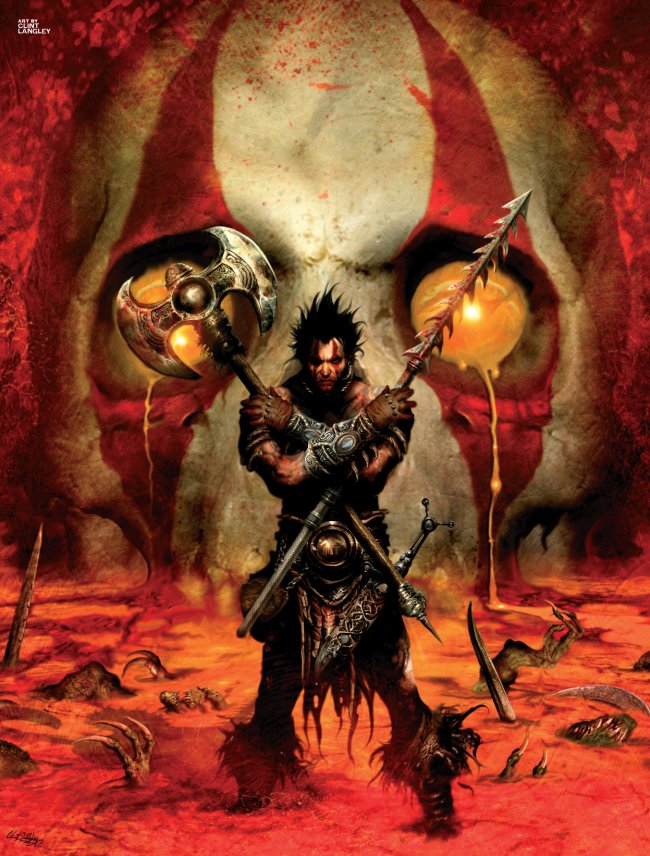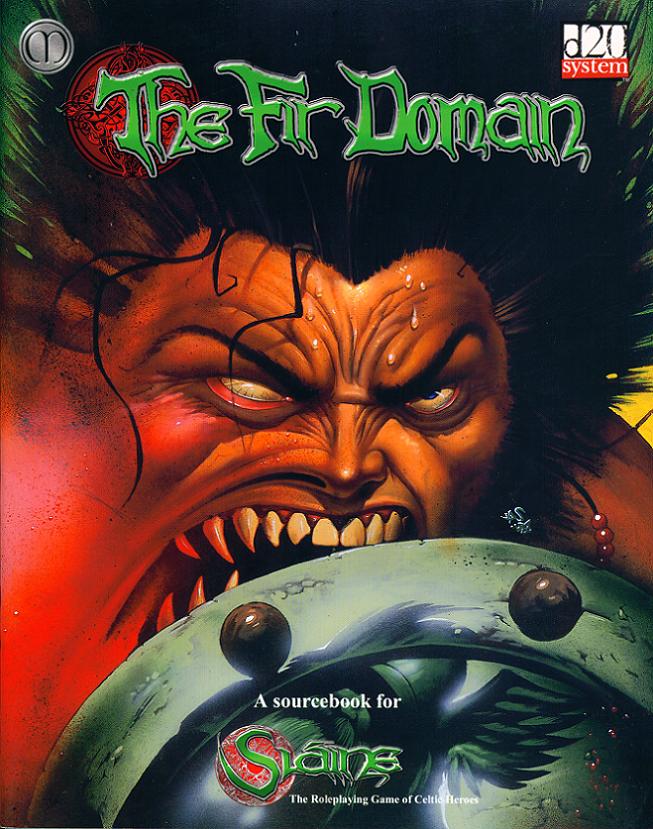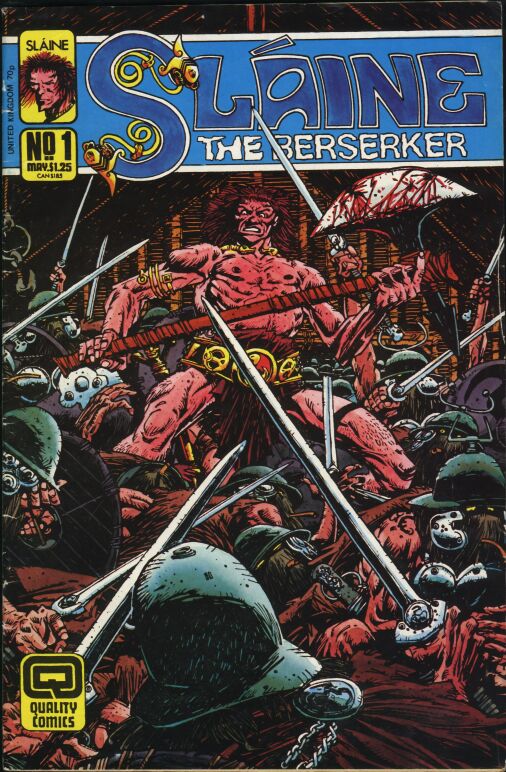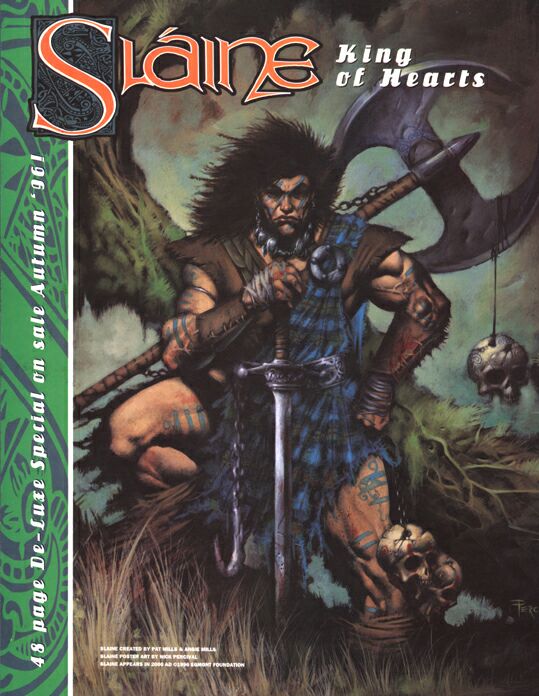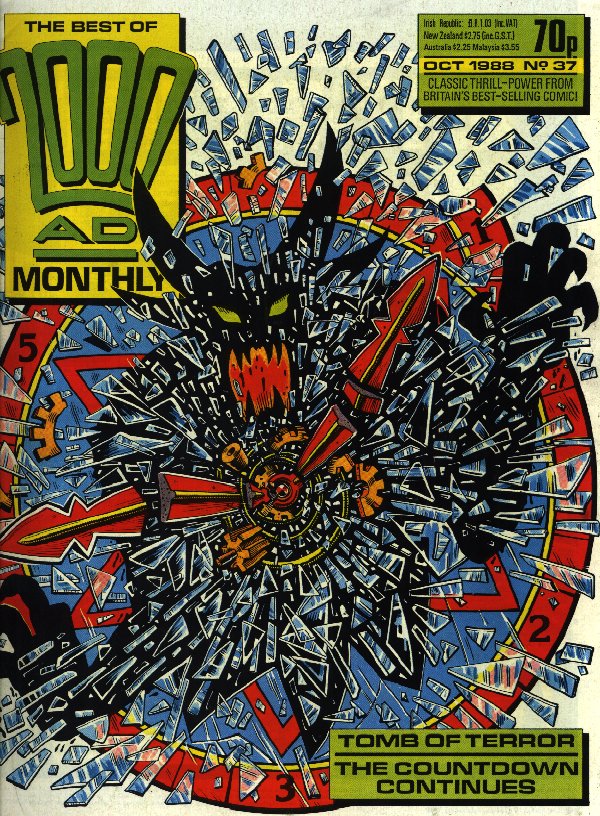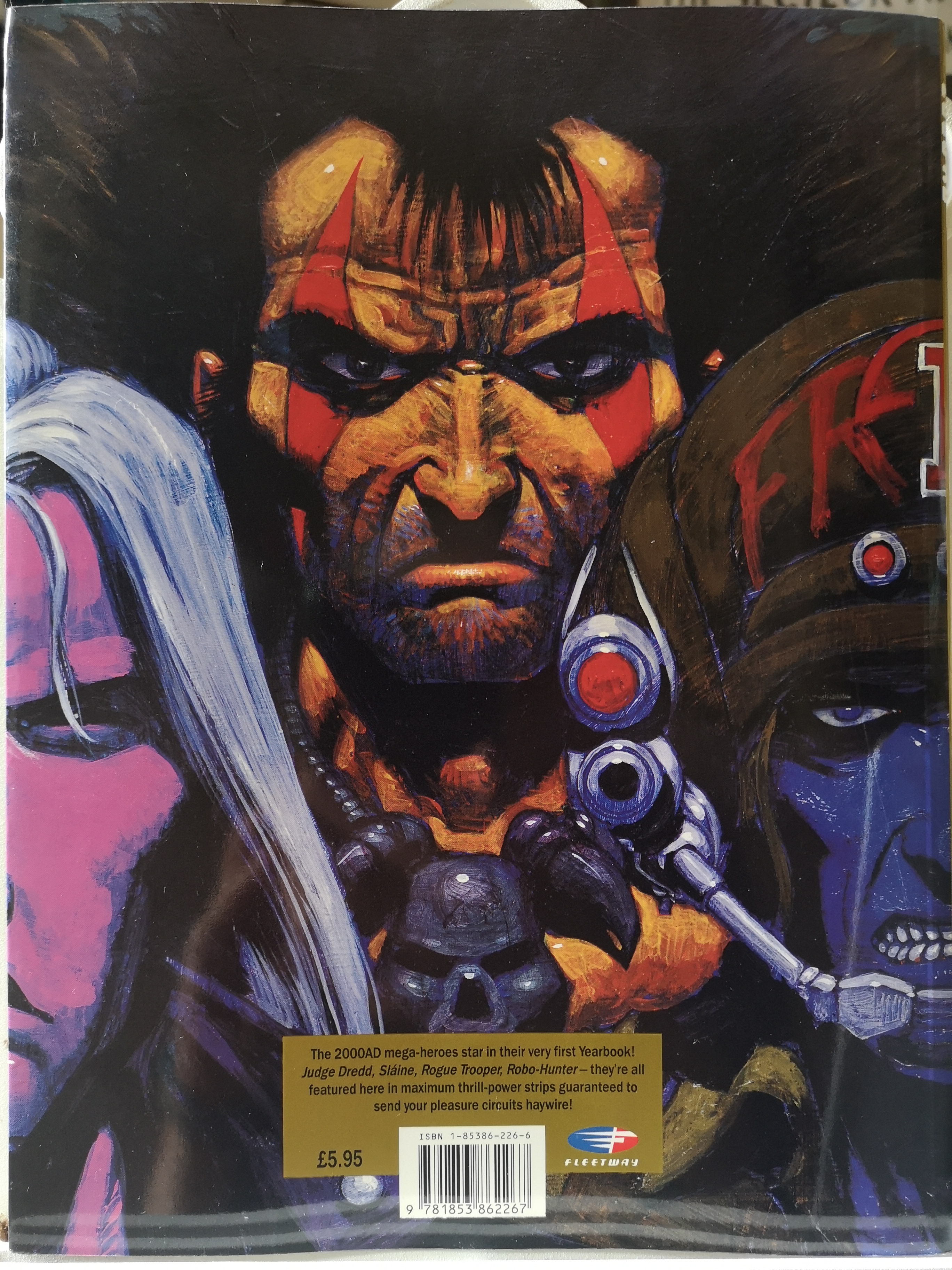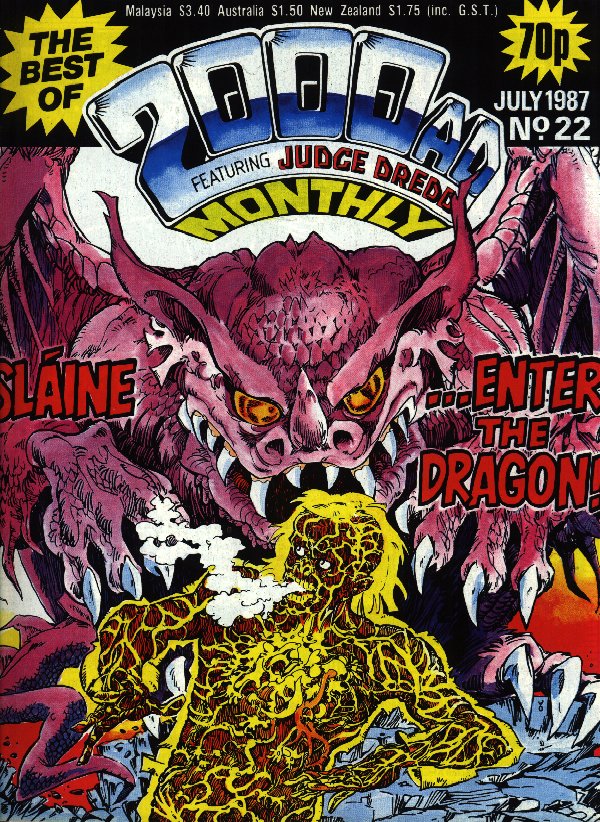So here we have it. I mean, I've split this last set of rankings into three, but it's not much of an argument to say it's all one and the same thing...
Rank 3/60: The Horned God Book I*
by Pat Mills and Simon Bisley
 |
Sláine was never supposed to have the body of an 80s action movie star...
but it kinda suits him, no?
Art by Simon Bisley |
Where to read it: The Horned God. Or the Horned God. This book has been collected a lot of times. Including an audio version!
Original run: Progs 626-635 (in the Year 1989; this is story 19.1 in sequence)
The plot: Sláine must ready his people to fight
against attack by the wicked sea-based Formorians from the north, and Slough
Feg and his skull-swords from the South. After much discussion with his Druid
and the earth Goddess, he decides to unite the tribes of Tír na nÓg, bringing
together four great and magical weapons – beginning with Rudriage and the spear
that can cut through anything. I can’t stress enough how much of the plot of
this specific book is scene-setting and discussion, before there’s a bit with a monster.
Essential pre-reads: There’s a fairly comprehensive
‘previously on’ to open up this tale, so you could easily not have read any
prior chapters. But if anything is ‘essential’, it’s Bride of Crom and Slaine
the King.
Analysis: Somehow, impossibly, this story marks a
step up from Sláine the King, both in terms of how much philosophizing and
context-setting and theology fills up the story, AND in how much more grown-up
and weirder and wonderfuller the art is, especially compared to other UK/US
comics of the time. Even more surprising, the two things kind of go together
perfectly. A lesser artist – perhaps even Glenn Fabry – might have ended up
drowning under the weight of Mills’s preaching. But any less pretentious words might’ve
got lost under the chaos of Bisley. Not saying that Fabry is less good at drawing (he's miles better), or less good at storytelling (he's a comics great) - but for me his commitment to realism takes away from the rather impossible lunacy of the actual story being told, at times. Anyway, Fabry is great, Bisley is great, but Bisley's greatness vibes with this whole thing somehow even more betterer.
 |
I don't know how he does it, but Bisley manages to be both not as good
as e.g. Belardinelli at drawing landscapes, or as Fabry is at drawing faces...
and yet overall it just communicates Sláine to perfection. |
Maybe the secret to it all is the scenes with aged Ukko
writing the saga. It’s a total indulgence of writing and art, filled to the
brim with meta-humour about being a writer. But by gosh it’s funny, compelling
stuff, and manages to make a virtue of exposition. You look forward to these
scenes of a grumpy dwarf sat at a writing desk. Mills has, in later life,
turned out to be someone who loves writing about his own writing process, his
muses and so on. I guess he first turned that tap on here, and the fun gushed
out. Bisley, too, has the exact same impish sense of humour that the whole
point is to both make Sláine and his world look hyper-cool, but also to poke
fun at it.
 |
Not many people have a character to represent their own ego on the page. Mills, we salute you.
Art by Simon Bisley |
I guess it helps especially that the meat of the story here
is Sláine chatting first to Cathbad the druid, and then to Danu the goddess,
about Celtic theology. As ever, there’s a baked-in problem that the discussion
is mostly about how right is it that women should be in charge of everything,
within the pages of the manliest man comic that was ever written and drawn by
men, about men, mostly for men. (It sucks to high Heaven that co-creator Angie Kincaid only got to do two Sláine stories, but it rather fits thematically...)
 |
Did you forget too, Pat?
Art by Simon Bisley (rushed edition)
|
Look, as Sláine stories, go, at least this one has
significant presence from no fewer than four interesting female characters:
Nest the scolding academic, Niamh the hyper-competent warrior queen, Medb the wicked, and Danu
the trickster, but it still doesn’t pass any variation of a Bechdel test. The
point is, Sláine is very much the focus, as is the question not of ‘should men
or women be in charge’ but rather ‘is it OK for Sláine to want to be High King?’
(answer yes, basically, but he should feel ashamed about it), and ‘Who is the
Horned God and what is his function?’ (Answer: Danu’s consort and main presence
on Earth, who should be chaotic but not as death-obsessed as Slough Feg,
please.)
Ultimately, the philosophizing and debating comes down to:
Priests – not to be trusted, even if they have the ‘correct’
beliefs.
Kings/Heroes – not to be followed, because they SUCK.
Bad guys such as Medb and Slough Feg – worth more respect than e.g. Christians,
at least they’re not hypocrites.
Women – believe that they are better than men, but also never trust them (and
implicitly assume that ‘you’, dear reader, are a man).
Oh, and then there's a fun bit where Sláine and Niamh fight a monster at the end. Because this IS a comic about an olden days warrior getting into fights, after all.
 |
We don't ask why Niamh shows up with long curly blonde hair in this story.
Art by Simon Bisley |
Repercussions: Sláine encounters Niamh again; Medb
and Slough Feg are set up as the main villains of this story, and perhaps of
more lasting consequence Sláine really goes to town on his main druid, Cathbad
– basically learning/deciding that he (Sláine) has the better access to and
understanding of the Earth Goddess’s true purpose for her people, especially
including Sláine. Over the course his saga Sláine has several encounters with
Danu, in her three guises, but the one here might just be the most clear and
direct.
Also, and maybe I missed this in Sláine the King, but it
is mentioned in passing here that the old king – the one betrayed by Medb – is
Sláine’s brother? Is that like a metaphorical ‘Celtic brother-king’? It kind of
reads more like a literal parent-bonded brother thing, which 100% flies against
the origin of Sláine as a commoner? Anyway, this is a thread that’s not pulled
on again so I’m inclined to ignore it…
Writing: 10/10: it’s funny, it’s interesting, it’s
deep, it’s pretentious, it’s straightforward. Mills in his prime, maybe?
Art: 7-10/10 – can’t stress enough how loose Bisley is with his
characters, and how clear it is that he really REALLY wanted to paint some bits
of the story, and could barely be bothered with other bits. And yes, there are
times when his character work and storytelling skills are pretty naïve.
That said, the poetry of the art is incomparably delightful. And there is a
plethora of just totally radical and amazing panels, pages and bits of comedy
marginalia. There’s a reason a generation of artists went mental when they saw
this book in particular, even though a lot of them were, technically, better
drawers than young Biz.
-which is as good a place as any to bring up a pet theory
I’ve been developing over this Sláine re-read – comics are easier and indeed
more fun to read when the artist is NOT perfect on every page and panel. When
they rush some bits, or are slapdash. When you can kind of skim through it all
and not worry you're being disrespectful, and when the existence of errors feels
like you’re with real people, rather than watching still moments in time…
Brainball count: in a flashback, 1 (although the
caption suggests a full 470 Sea demons die at Sláine’s hand). In the story
proper, 1 monster (that Sláine doesn’t so much kill as trick into eating itself).
*An asterisk (but not an Asterix) to note that, as much as Mills hates the Romans and thinks we Brits pay them far too much respect, he was not above using their numerals to make his epic comics look cool :))
Rank 2/60: The Horned God Book II
by Pat Mills and Simon Bisley
 |
Not the first or last 2000AD cover with a visible penis, but certainly the most obvious.
Art by Simon Bisley |
Where to read it: The Horned God
Original run: Progs 650-656; 662-664 (In the year 1989, spilling into 1990; story 18.2 in sequence)
The plot: Sláine continues his quest to unite the
tribes, specifically here by obtaining the Spear of Lug, and the Stone of
Destiny, and learning which of the four tribal Kings will be declared High King
(the answer won’t surprise you).
Essential pre-reads: this follows on directly from
the Horned God part 1. Would be a very weird place to start with book 2 😊
Analysis: This is the bit of Horned God with the most
plot and action, but it’s still very light on fighting. I mean, there’s a bit
where Sláine fights a ‘ghost dragon’, but the biggest action sequence belongs
to a sort of underwater Neanderthal-type creature called the Avanc, who
unleashes some serious bloodletting.
Look, I can see why you'd question my choice to separate out the three
‘books’ of the Horned God, since they read as a unit so neatly, and no doubt
were written that way. But the art, in my mind, does undergo quite a bit
of change in each sequence. Where Book 1 was filled with lush and ludicrous
pin-up poses, Books 2 is more ‘classical’ comics, with story unfolding. Partly
no doubt because there’s less talking and more stuff happening, but maybe also
because Bisley was developing his comics chops? For me it’s less spectacular
than Book 1, but far more consistent (well apart from Niamh’s hair).
Anyway, what about the story? Well, there’s more effortless
worldbuilding from Mills, who shows us around two other tribes of Tir-Nan-Og,
and introduces us to more Celtic customs. King Gann of Finias is dour and
self-deprecating to the point of being a bit of a loser – but is also portrayed
as someone Sláine actually likes. Mills has fun showing his tribe of people who
will ‘happily’ put up with a bad lot. He’s also the holder of the spear of lug,
an extraordinary Bisley-creation that is connected to some seriously sci-fi
looking pipes that help it drain blood. Of all the ‘treasures’, this is the one
that comes up again most often down the line – and it’s notable that every
artist to depict it always goes back to the basic Bisley look.
 |
Those fiery reds! It's like living lava on the page.
Art by Simon Bisley |
Meanwhile Sengann of Murias is comics’ greatest madman, and
gets, for me, the best-drawn Bisley action of the book. His tribe has to cope
with the curse of the Stone of Destiny – and it’s a neat touch to have this
‘treasure’ very openly portrayed as something that brings more harm than good.
 |
Ah, pronoun comedy. The classics can still deliver!
Art by Simon Bisley |
Of course I suspect the sequence most people remember from the
book is the really fun bit where Sláine ‘distracts’ Medb, while Nest and Ukko
(mostly Ukko) dive underwater to steal the stone.
 |
You mean you don't remember this panel? I do.
Art by Simon Bisley |
It’s a lovely bit of heist
comics, where the key is not so much the heist itself (although Ukko/Bisley
doing a Fungus the Bogeyman impression is very welcome) – it’s the preamble.
Now, Mills is very much having his cake and eating it. He makes a serious point
about ‘the Horned God’ NOT being the kind of person who has Batman-like
planning skills, and answers to all problems, and even allows himself to wallow
in the misery of losing. And thematically, this feels appropriate to the
picture Mills wants to paint of what kind of a ‘hero’ Sláine is.
But it’s all a feint! In fact, Sláine (or maybe more likely
Niamh) DO have a Batmanesque cunning plan, which they execute and we readers
enjoy watching. Which is it, Mr Mills? I suppose the answer is ‘both’, although
it’s still a cheat. (and again, I suspect Mills would say even more strongly
that cheating itself is the way of the Horned God par excellence…).
 |
For a few panels, you are reading a charming kids adventure comic after all.
Art by Simon Bisley |
And on top of all this, there’s one of the best ‘aged Ukko
writing the saga under duress’ gags in the whole sequence, where he prays to
the God of authors.
Anyway, it all adds up to making this book the one I have
the most fun with, and would most happily dip into multiple times, if for some
reason I ever decide not to just re-read the whole ‘Horned God’ epic in one go. But, as you'll very soon see, I do think Book III ties everything together so neatly, and with such vigour, that I have to rank it just one slot higher...
Repercussions: Sláine gets all four treasures, and is
duly named High King. The stage is set for ‘final’ battle with Slough Feg and
the Formorians. Also, Medb is revealed to all as a villain. Also also, this book
is the turning point for Niamh being willing to a) forgive Sláine his past sins
and b) let herself love him again.
Writing: 10/10
Art: 9/10 I've said before how Bisley on fire is the best there ever was, but sometimes he's just not feeling very warm?
Brainball count: 2 humans and 1 dragon. Honestly in this epic so far you'd think Sláine wasn't even interested in killing people.
Rank 1/60: The Horned God Book III
by Pat Mills and Simon Bisley
 |
That horse, though!
Art by Simon Bisley |
Where to read it: The Horned God
Original run: Progs 688-698
The plot: It’s the Big Battle! Actually 2 battles –
first vs the Fomorians, then vs the Skull Swords. Actually 3 battles! Because
Medb comes for revenge, too.
Essential pre-reads: Horned God volumes 1 and 2
wouldn’t be a bad idea.
Analysis: So, I’ve scored this as the one and only Sláine
story where absolutely everything is firing on all cylinders. To be fair to Pat
Mills, he’s on top form for the whole Horned God Saga, and may well have
written it all in one go, rather than in chunks. But for sure Bisley was
working in chunks of some kind, and it’s here in the third part where he
combines the extraordinary beauty of pin-up style pieces from Book 1, with the
consistency of art from Book 2. So, you know, this is BEST.
 |
This is just a small example of Bisley's expert combo of cartooning, storytelling,
monster design, vibrant gore winking at the camera, super-kewl posing... it's all here.
|
It's a very basic choice on my part. As Ukko himself
comments - at length – in this very
story, most readers like the bits with the hacking and slashing, and if you
come to the Horned God wanting violence on warp spasms and dragons and
beheadings and gae bolgas and blood flying everywhere -it’s all here in Book 3.
 |
Also busty ladies riding on dragons - can't forget those!
Art by Simon Bisley |
But, you know, there is still plenty of the theological
discussion I loved so much in Books 1 and 2. There’s also some real ‘what is the big picture of Sláine’ stuff here, where Ukko looks forward to the future
both of the Sláine saga and of Ireland’s / the Celts mythical history
generally.
So much so that this feels very much like a natural end
point for the whole of Sláine, and it’s common wisdom that if you just read
everything from The Time Monster to the end of the Horned God, you’re getting
amazing comics that all tell one amazing story, no messing. I don’t hold with
that view – not least because Mills out and out tells us right here that there
IS more story to tell. (Although to be fair, at times he does rather imply that this is going to be the final story.)
 |
Look at that skull! A memento mori for Sláine himself.
Art by Simon Bisley |
I think there’s also something about this
ending-that-isn’t-an-ending that points to one of the wider themes of Sláine
as a saga. Which is, that we don’t have to accept our lot in life. We live in a
notionally Christian country – and even if it’s mostly secular these days,
there’s still a sense that a kind of masculine version of ‘order’ prevails -
and Mills is preaching a conversion/reversion back to a more feminised way of
life. I won’t get into the concerns I have about what Mills thinks 'masculine' and 'feminine' mean*, and will instead
acknowledge that it’s part of the consistent story that Sláine basically always
‘wins battles’ on a personal level, but often ‘loses wars’ in a broader sense.
Danu may not care, but the tribes of the Earth Goddess sure don’t end well,
either in the Horned God or in any of the sagas to come, no matter how many of
the enemy Sláine dispatches.
 |
To be fair, Sláine DOES achieve a compelling and lasting victory
over Crom, the last vestige of Conan-comparison.
Art by Simon Bisley |
And the more the Sláine story goes on, whether it’s fighting
‘time-lost’ battles against invaders, or indeed the Books of Invasions which
explicitly ends with Sláine’s Celts disappearing form the ‘real world’, there’s
this idea that Sláine is always fighting for a champion who is destined to
‘lose’, even though we often get the satisfaction of seeing him ‘win’.
As Mills often says, not least in this Horned God finale,
such contradictory messaging is the way of the Horned God, and of Danu herself.
Repercussions: Let’s see, you’ve got 1 arch enemy
properly deaded (Slough Feg), another arch enemy sent away to lick her wounds
(Medb, who will return). One love-of-life to be wed (if only for a trial
period). One radical change of scenery – Tir-Nan-Og is flooded, creating I
guess the English Channel and the Irish Sea (and maybe the North Sea as well?),
so Sláine and the other high kings move to found new cities in Ireland. Don’t
think I’d quite appreciated until this re-read that the first batch of Sláine
stories take place in a bit of land that no longer exists, while the next phase
of the cycle is in Ireland proper. Kind of impressive how quickly people
managed to builds up e.g. Tara in that time (unless the 5 tribes just up and
conquered whoever was living in bits of Ireland before) – although this is the
trouble with combining myth, history and fantasy story telling!
Writing: 10/10
Art: 10/10
Brainball count: I count 18 on-panel, + 1 arch-enemy.
By implication it’s LOTS more, though, including ‘about 100’ in the first big
battle alone.
*worth noting that, in this story in particular, penises play a prominent part.
Well, that's the ranking done, just some tidying up to do...
